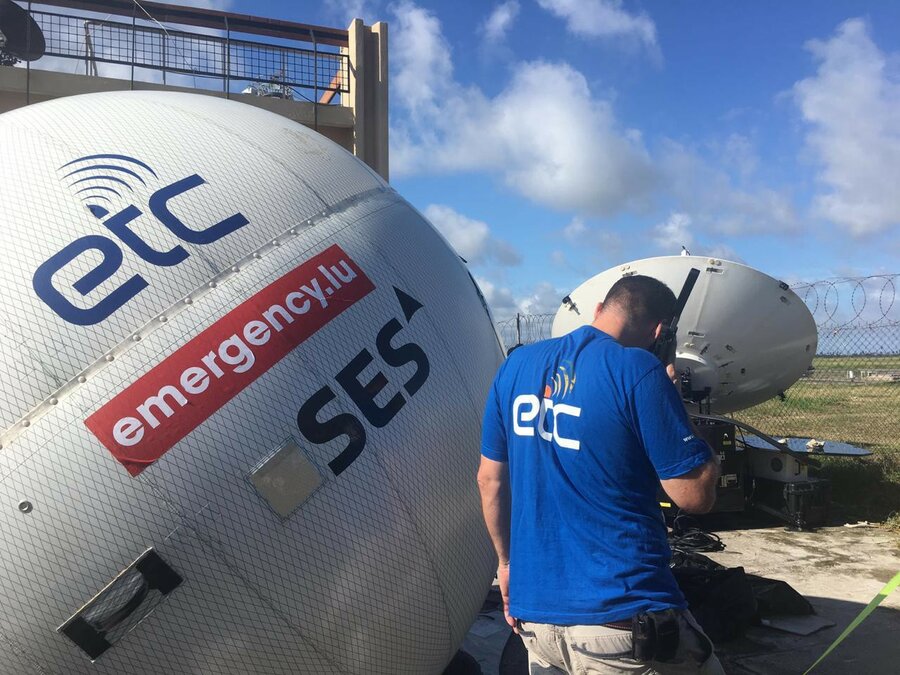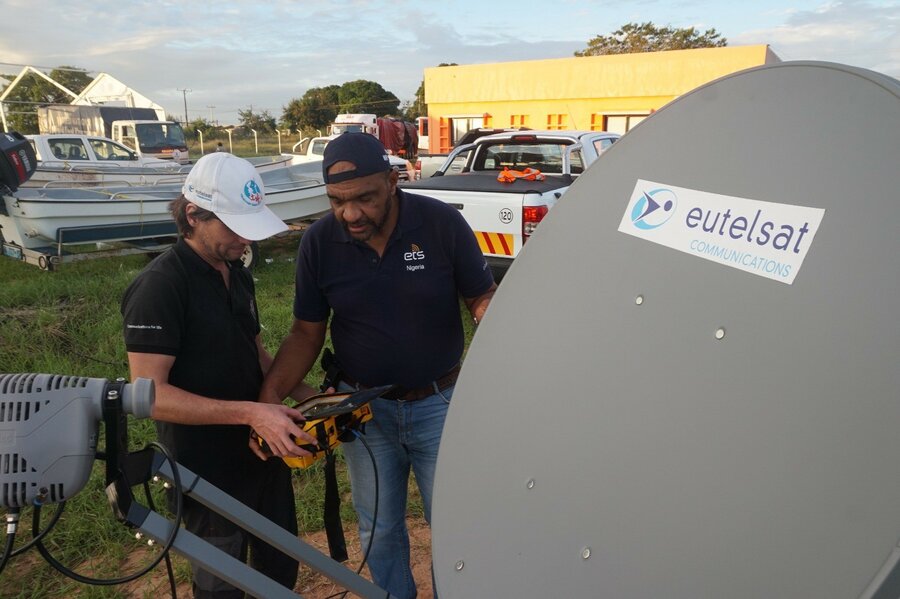Dishing out corporate humanitarianism
The phone call came at 02:00 am. Daniel Cooper, Head of Aid for the global, mobile satellite communications provider Inmarsat, was boarding a flight from Dubai. It was Omar Namaoui on the line, a Technical Project Officer for the Emergency Telecommunications Cluster (ETC), asking if Inmarsat was ready to fulfill its commitment to the Crisis Connectivity Charter (CCC).

"It was very easy to say yes," Daniel remembers. "Part of being able to say yes so easily is the fact that our coverage is global — we don't have to think twice."
Simon Gray, Senior Vice President of Humanitarian Affairs for Eutelsat, was on holiday when the call came in from Omar and he also said yes without hesitation. Eutelsat satellite circuits were operational within 24hrs.
Cyclone Idai, the largest tropical storm on record to hit Mozambique, destroyed thousands of homes and left an inland ocean over 3,000 kilometers squared in its wake. To do their lifesaving work, first responders needed communications support on the ground as soon as possible.
The first wave of ETC staff were on the ground within 48 hours of the cyclone; as with any disaster, it takes time to understand the enormity of the damage, but Charter signatories deployed equipment on a "no regret" basis at the risk of shipping more equipment than needed.
"For the Global ETC, having access to free equipment and bandwidth without worrying about who is going to pay the bill is a huge plus; the focus can then be on moving staff and equipment to arrive sooner and help humanitarians save more lives — faster," says Enrica Porcari, Chair of the ETC and Chief Information Officer for the World Food Programme (WFP).
Stepping up to the plate
The Charter's donation agreements were ratified by seven signatories in May 2018 — almost one year before cyclone Idai. The donations include expertise, training, free air-time and equipment from major satellite companies under one humanitarian umbrella. When a disaster rears its head, any of these providers can be approached to lend valuable connectivity support. Inmarsat, along with SES and Eutelsat satellites were the three signatories pinpointed for the Cyclone Idai response.
The three companies pitched in to give satellite phones and portable data terminals for early assessments on the ground, increasing communications hub capacities in Beira — the city that bore the biggest brunt of the storm's wrath. They also provided connectivity for the National Institute of Disaster Management (INGC) of Mozambique.
Preparedness may have been a factor in the seamless real-life activation of the Charter; rewind five months before Idai, and Omar of the ETC was running a simulation for all signatories to experience how they would deploy in an actual emergency.
Rising to the occasion
"Inmarsat has been active in [the] humanitarian sector for 20-plus years," Daniel says. "To be able to formalize this into one charter for the ETC is fantastic."
Trust and mutual understanding are needed for the corporate and humanitarian spheres to spin side by side. This "doesn't always come naturally," says Alan Kuresevic, Vice President of Engineering for SES Satellites, which is also a mainstay company in the humanitarian space through its work with the Government of Luxembourg's IT disaster response platform, emergency.lu.
"There is a great opportunity for a more scale-able and synergistic approach through closer partnership," Alan says. "We are glad that we built a relationship with several humanitarian actors (including WFP and the ETC) that go well beyond that point."
The Charter is "a real step forward," reflects Eutelsat's Simon Gray. "Eutelsat has been working with the humanitarian sector for over 25 years, donating expertise, communications solutions and financial support to initiatives such as Télécoms Sans Frontières and NetHope. Satellite solutions are vital in establishing high-speed connectivity in crisis situations and by supporting the Charter we are reinforcing our commitment to humanitarian causes."
"The Charter is a formal structure that we have put in place and have all agreed at the highest levels of our companies. This shows how collegiate the satellite industry is. We are also the first industrial sector to really come together for humanitarian purposes," adds Simon, who also acts as the private sector coordinator of the Charter with the ETC. He's worked for several years to find the terms needed to bridge the corporate and humanitarian worlds.
A unifying signal
As a forum for humanitarian communications specialists that gathers United Nations (UN), non-governmental, governmental and corporate entities, the ETC is in a unique position to drive collaborations and planning that might otherwise be disparate.

The International Telecommunication Union (ITU), the UN agency that coordinates global telecommunication activities, is a partner of the ETC that will prove indispensable to the proper functioning of the Charter. It's a golden opportunity for UN inter-agency cooperation as well.
It partly comes down to lobbying for customs and import regulations: shipping equipment into countries after a disaster can pose problems for private sector companies involved in emergency response. "Most of the satellite players will experience these issues," says Simon. "Having the ITU and WFP on board has got to be good for the industry and for the country, because aiding and rebuilding continues on way past the emergency."
"Together we can optimize our disaster response and provide tools and platforms that allow organizations to communicate internally, to coordinate with other humanitarian agencies, and to reach out to communities in need to save lives," says Doreen Bogdan-Martin, Director of the Telecommunication Development Bureau of the ITU. "It is through such collaboration and partnerships that we can create new and innovative opportunities to enhance disaster resiliency and risk reduction," she says.
As a Charter coordinator, Simon also takes time to think about what's coming next. Preparedness measures are a top priority for the ETC and the Charter. "Why wait until after a disaster?" Simon says.
"Why not be thinking about disaster resilient communication networks that can be part of an integrated ICT strategy so are already in place and can therefore be activated seamlessly?" he adds. The Charter is part of a high-tech evolution of "real coordination between actors in the humanitarian world and the private sector," Simon says. "I hope it is a permanent addition to the disaster response landscape."


